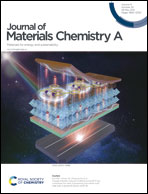Revealing the effect of interfacial electron transfer in heterostructured Co9S8@NiFe LDH for enhanced electrocatalytic oxygen evolution†
Abstract
Heterointerface engineering is a desirable way to rationally design efficient and low-cost electrocatalysts for the oxygen evolution reaction (OER). Herein, urchin-like Co9S8@NiFe layered double hydroxide (Co9S8@NiFe LDH) heterostructured hollow spheres are assembled from Co9S8 hollow spheres as the core and porous NiFe LDH nanowires as the shell. The heterostructured hollow spheres show a small overpotential of 220 mV at a current density of 10 mA cm−2, a low Tafel slope of 52.0 mV dec−1, and robust stability, which is better than that of commercial IrO2 and most reported non-precious electrocatalysts. Density functional theory (DFT) calculations show that the synergetic effect at the interface could improve the electrical conductivity of Co9S8@NiFe LDH, induce electron transfer from NiFe LDH to Co9S8, and lower the energy barriers of intermediates for the OER, leading to enhanced electrocatalytic activity. Meanwhile, the urchin-like hollow structure with nanopores and super-hydrophilicity can provide desired structural stability, facilitate ion penetration and release bubbles, improving the accessibility of active sites and thereby boosting OER catalytic performance. This work provides a viable route to develop high performance electrocatalysts for the OER.



 Please wait while we load your content...
Please wait while we load your content...
